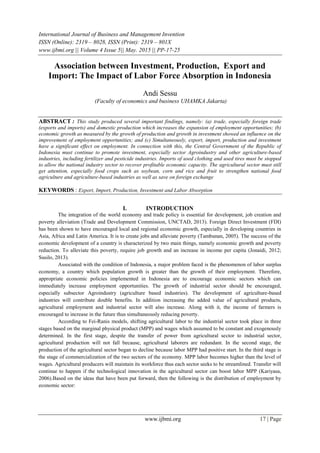This study examines the relationship between investment, production, export, and import on employment absorption in Indonesia. Findings indicate that trade and economic growth significantly enhance employment opportunities, and suggest that the government should promote investment in agriculture and manufacturing sectors while eliminating detrimental imports. The analysis highlights the importance of fostering a conducive environment for domestic and foreign investment to stimulate job creation and alleviate poverty.







![Association between Investment, Production…
www.ijbmi.org 24 | Page
VI. CONCLUSION AND RECOMMENDATIONS
Based on the results of the analysis can be concluded that trade (exports and imports) along with
production is useful to increase employment opportunities. Economic growth is measured by the growth in
production and investment growth shows its effect on increasing employment opportunities. Simultaneously,
exports, imports, production and investment have a significant effect on employment.
Indonesian government is urged to keep encouraging investment, especially sector Agroindustry and
other agriculture-based industries, including fertilizer and pesticide industries. Imports of used clothing and used
tires must be stopped to allow the recovery of the industrial sector to do business profitably economic capacity.
The agricultural sector must still get attention, especially food crops such as soybean, corn and rice, and fruits. It
is intended to strengthen the national food agriculture and conserve foreign exchange.
REFERENCES
[1] Arsyad, Lincolin. (2005). Pengantar Perencanaan Pembangunan Ekonomi Daerah, Edisi Kedua,
Penerbit BPFE: Yogyakarta
[2] Badrudin, Rudy. (2012). Ekonomika Otonomi Daerah. UPP YKPN, Yogyakarta
[3] Badan Pusat Statistik. (2000). Statistik Indonesia. BPS, Jakarta.
[4] ---------------------------. (2013). Statistik Indonesia. BPS, Jakarta.
[5] Cu Chi Loi. (2010). Impact of Economic Integration on Employment and Poverty Reduction in
Vietnam. Diakses tgl. 24 Maret 2015
[6] Dornbusch, Rudiger., Stanley Fischer, dan Richard Startz. (2004). Macroeconomics.. McGraw-Hill,
Irwin
[7] Feldstein, Martin; dan Charles Horioka,. (1980). Domestic Saving and International Capital Flows,
Economic Journal90 (358): 314–329, JSTOR 2231790
[8] Ghozali, Imam. (2005). Aplikasi Analisis Multivariate dengan Program SPSS. Badan Penerbit
Universitas Diponegoro. Semarang
[9] Hengki Idris Issakh. (2013). Peluang Dan Tantangan ukm Dan Industri Jasa Indonesia Menghadapi
Masyarakat Ekonomi ASEAN 2015. Candi Mas Metropole. Jakarta.
[10] Jhingan, M.L. (2004). Money, Banking, International Trade and Public Finance. Vrinda Publications,
New Delhi, India.
[11] Jonaidi, Arius. (2012). Analisis Pertumbuhan Ekonomi dan Kemiskinan di Indonesia. Jurnal Kajian
EkonomiVolume 1, Nomor 1, April 2012, pp. 140-164, diakses tgl. 24 Maret 2015
[12] Kariyasa, Ketut. (2006). Perubahan Struktur Ekonomi dan Kesempatan Kerja serta Kualitas
Sumberdaya Manusia di Indonesia. Diunduh dari
http://download.portalgaruda.org/article.php?article=13009&val =926 tgl. 24 Maret 2015
[13] Khan, Azizur Rahman. (2007). Growth, Employment and Poverty: An Analysis of the Vital Nexus
Based on Some Recent UNDP and ILO/SIDA Studies. DESA Working Paper No. 49
ST/ESA/2007/DWP/49. Diunduh tgl. 24 Maret 2015
[14] Kurniati, Yanti dan Yanfitri. (2010). Dinamika Industri Manufaktur dan Respon Terhadap Siklus
Bisnis. Buletin Ekonomi Moneter dan Perbankan, Oktober 2010, pp. 135-168, Jakarta
[15] Mankiw, N. Gregory. (2003). Teori Makroekonomi. Edisi Kelima. Erlangga. Jakarta
[16] Mukhlis, Imam. (2012). Aliran Foreign Domestic Investment dan Produk Dometik Bruto Indonesia.
Jurnal IESP, FE Universitas Negeri Malang, Vol. 4 No.2 November 2012, pp. 191-200
[17] Makmun dan Ahmad Yasin. (2003). Pengaruh Investasi dan Tenaga kerja Terhadap PDB Sektor
Pertanian, Jurnal Kajian Ekonomi dan Keuangan Vol.7 No.3 September
[18] Rahayu, Teguh Imam. (2014). Teori Pembangunan Dunia ke-3 Dalam Teori Modernisasi Sub Teori
Harrod-Domar (Tabungan dan Investasi). Diunduh dari
http://download.portalgaruda.org/article.php?article=142386 &val=5460 tgl. 24 Maret 2015
[19] Republik Indonesia. (2003).Undang-Undang Republik Indonesia No. 13 Tahun 2003 tentang
Ketenagakerjaan.
[20] Solow, Robert M. (1956). A Contribution to the Theory of Economic Growth. The Quarterly Journal of
Economics, Vol. 70, No. 1. pp. 65-94.
[21] Susilo, Heru Prasetyo. (2013). Pengaruh Investasi dan Tenaga Kerja terhadap Output Sektor Industri
Kecil: Analisis Panel Data. Jurnal Studi Ekonomi Indonesia Fakultas Ekonomi Universitas Sebelas
Maret, diakses dari situs: http://eprints.uns.ac.id/1796/1/1-1-1-PB.pdf, tgl. 24 Maret 2015
[22] Tambunan, Tulus. (2001). Perekonomian Indonesia: Teori dan Temuan Empiris. Jakarta, Ghalia
Indonesia.
[23] Todaro, Michael P. (2003). Economic Development. Edisi 8 (terjemahan). Penerbit Erlangga, Jakarta
[24] Trade and Development Board UNCTAD. (2013). The Impact of Trade on Employ-ment and Poverty
Reduction. UN Conrference on Trade and Development, Jenewa 2013, Diakses tgl. 24 Maret 2015](https://image.slidesharecdn.com/c045017025-150619041553-lva1-app6892/85/Association-between-Investment-Production-Export-and-Import-The-Impact-of-Labor-Force-Absorption-in-Indonesia-8-320.jpg)
